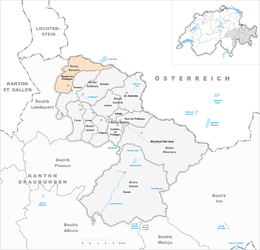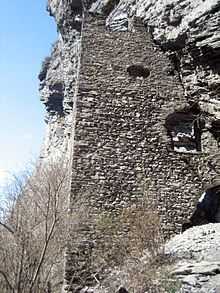Seewis im Prättigau
| Seewis im Prättigau | ||
|---|---|---|
 | ||
| ||
 Seewis im Prättigau | ||
|
Location of Seewis im Prättigau  | ||
| Coordinates: 46°59′N 9°38′E / 46.983°N 9.633°ECoordinates: 46°59′N 9°38′E / 46.983°N 9.633°E | ||
| Country | Switzerland | |
| Canton | Graubünden | |
| District | Prättigau/Davos | |
| Area[1] | ||
| • Total | 49.63 km2 (19.16 sq mi) | |
| Elevation | 937 m (3,074 ft) | |
| Population (Dec 2013[2]) | ||
| • Total | 1,372 | |
| • Density | 28/km2 (72/sq mi) | |
| Postal code | 7212, 7214 | |
| SFOS number | 3972 | |
| Surrounded by | Brand (AT-8), Fanas, Grüsch, Jenins, Maienfeld, Malans, Nenzing (AT-8), Schiers, Valzeina, Vandans (AT-8) | |
| Website |
www SFSO statistics | |
Seewis im Prättigau is a municipality in the district of Prättigau/Davos in the Swiss canton of Graubünden.
History
Seewis im Prättigau is first mentioned in 1224 as de Sevve.[3]
In 1622, Fidelis of Sigmaringen a Capuchin friar, was martyred in the Counter-Reformation at Seewis.
Geography

Seewis im Prättigau has an area, as of 2006, of 49.6 km2 (19.2 sq mi). Of this area, 41.3% is used for agricultural purposes, while 34% is forested. Of the rest of the land, 2% is settled (buildings or roads) and the remainder (22.6%) is non-productive (rivers, glaciers or mountains).[4]
The municipality is located in the Seewis sub-district of the Prättigau/Davos district. It is located on a terrace on the right valley side at the entrance to the Prättigau valley. It consists of the village of Seewis im Prättigau and the sections of Schmitten-Pardisla and the Seewis-Valzeina train station on the valley floor. Until 1961 Seewis im Prättigau was known as Seewis im Prätigau.[5]
Demographics
Seewis im Prättigau has a population (as of 31 December 2013) of 1,372.[2] As of 2008, 10.7% of the population was made up of foreign nationals.[6] Over the last 10 years the population has grown at a rate of 9%. Most of the population (as of 2000) speaks German (93.3%), with Albanian being second most common ( 2.3%) and Serbo-Croatian being third ( 1.3%).[4]
As of 2000, the gender distribution of the population was 48.5% male and 51.5% female.[7] The age distribution, as of 2000, in Seewis im Prättigau is; 202 children or 15.3% of the population are between 0 and 9 years old and 195 teenagers or 14.7% are between 10 and 19. Of the adult population, 128 people or 9.7% of the population are between 20 and 29 years old. 223 people or 16.9% are between 30 and 39, 188 people or 14.2% are between 40 and 49, and 129 people or 9.8% are between 50 and 59. The senior population distribution is 101 people or 7.6% of the population are between 60 and 69 years old, 91 people or 6.9% are between 70 and 79, there are 61 people or 4.6% who are between 80 and 89 there are 5 people or 0.4% who are between 90 and 99.[6]
In the 2007 federal election the most popular party was the SVP which received 38.8% of the vote. The next three most popular parties were the SP (25.8%), the FDP (23.1%) and the CVP (6%).[4]
In Seewis im Prättigau about 68.5% of the population (between age 25-64) have completed either non-mandatory upper secondary education or additional higher education (either university or a Fachhochschule).[4]
Seewis im Prättigau has an unemployment rate of 0.84%. As of 2005, there were 104 people employed in the primary economic sector and about 38 businesses involved in this sector. 234 people are employed in the secondary sector and there are 15 businesses in this sector. 208 people are employed in the tertiary sector, with 41 businesses in this sector.[4]
From the 2000 census, 186 or 14.1% are Roman Catholic, while 923 or 69.8% belonged to the Swiss Reformed Church. Of the rest of the population, and there are 34 individuals (or about 2.57% of the population) who belong to another Christian church. There are 74 (or about 5.59% of the population) who are Islamic. There are 4 individuals (or about 0.30% of the population) who belong to another church (not listed on the census), 64 (or about 4.84% of the population) belong to no church, are agnostic or atheist, and 38 individuals (or about 2.87% of the population) did not answer the question.[6]

The historical population is given in the following table:[3]
| year | population |
|---|---|
| 1850 | 791 |
| 1900 | 901 |
| 1950 | 955 |
| 1970 | 923 |
| 2000 | 1,323 |
Heritage sites of national significance
The ruins of Castle Fracstein are listed as a Swiss heritage site of national significance.[8]
-

Castle Fracstein in 1830
-

Fracstein castle from the south
-

Fracstein interior
References
- ↑ Arealstatistik Standard - Gemeindedaten nach 4 Hauptbereichen
- ↑ 2.0 2.1 Swiss Federal Statistics Office – STAT-TAB Ständige und Nichtständige Wohnbevölkerung nach Region, Geschlecht, Nationalität und Alter (German) accessed 18 August 2014
- ↑ 3.0 3.1 Seewis im Prättigau in German, French and Italian in the online Historical Dictionary of Switzerland.
- ↑ 4.0 4.1 4.2 4.3 4.4 Swiss Federal Statistical Office accessed 30-Oct-2009
- ↑ Amtliches Gemeindeverzeichnis der Schweiz published by the Swiss Federal Statistical Office (German) accessed 23 September 2009
- ↑ 6.0 6.1 6.2 Graubunden Population Statistics (German) accessed 21 September 2009
- ↑ Graubunden in Numbers (German) accessed 21 September 2009
- ↑ Swiss inventory of cultural property of national and regional significance 21.11.2008 version, (German) accessed 30-Oct-2009
| Wikimedia Commons has media related to Seewis. |
External links
- Official Web site (German)
| ||||||||
